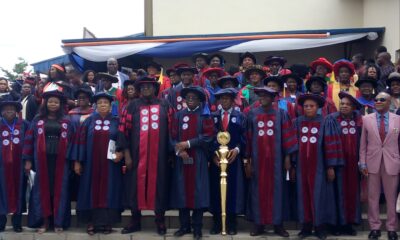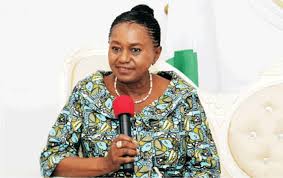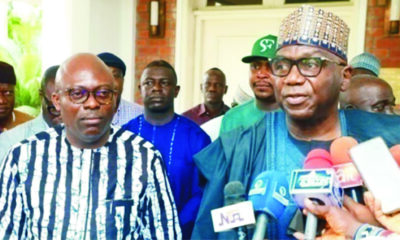Oil & Energy
Towards Efficient Metering Of Customers’ Houses
The recent directive by the Nigeria Electricity Regulatory Commission (NERC) that distribution companies (DISCOs), under the Power Holding Company of Nigeria (PHCN) should ensure the metering of all customers’ houses across the country within 18 months could simply be seen as a blue-Peter or blanket-bath for the unbundled power company.
It has since been noticed by Nigerians that even when houses are metered, NEPA/PHCN staff do not read meters before billing, rather they deliberately estimate and issue ‘crazy bills’ and charging consumers for power they did not consume. Even the distribution companies claim that average consumption of those who were adequately metered was applied to a cluster of residence to arrive at estimated consumption and customers believe that the DISCOs calculations for estimated billing were not based on established scientific or reliable parameters.
Eyo Ekpo, the Commissioner for Marketing, Competition and Rates of the NERC had ordered all the DISCOs to submit their metering plans for an effective billing system, adding that the distribution companies were expected to complete the metering process between 12 and 18 months.
“We have told them that between 12 and 18 months, they should be able to meter all houses of their customers” , Ekpo said.
According to him, NERC is determined to ensure greater number of meter distribution to customers.
The main issue bothering customers and Nigerians as a whole is not the metering of their houses but the question is, are PHCN staff prepared to read the meters and give consumers accurate bills?
Metering of electricity in Nigeria, according to a report submitted by the Metering Inquiry Committee, began with the production and consumption of electricity around 1895. The system and process are, however, bedeviled by inefficiencies and corrupt practices.
Historically, electricity metering was centrally coordinated with the various units of NEPA/PHCN at the distribution end relying on the procurement apparatus at the headquarters to procure and distribute meters to customers through three central stores. This inefficient system led to a backlog of meter requests by customers who pay for such services without the meters being installed.
The resultant effect has been the institutionalization of the unwholesome practice of estimated billing and the attendant customer dissatisfaction and disappointment, which partly accounts for consumers’ refusal to register for meters.
It is against this backdrop that the Metering Inquiry Committee was set up to garner data and information on the root cause of the endemic metering crisis in the country which impacts the electricity sector negatively. During its assignment a few weeks ago, the committee discovered that less than 50 per cent of the registered customers in the Nigerian Electricity sector are metered.
This has led to the prevalent practice of arbitrary charges based on unscientific estimation of electricity consumed by customers by the DISCOs in order to meet up with their overhead costs in an environment of inefficiency and dwindling supply of electricity.
According to the committee’s report, the total number of customers captured in the records of operators of the Nigerian Electricity Supply Industry is 5,172,979, which represents 18.65 per cent of Nigeria’s total households put at 28,900,492 as provided by records from the National Bureau of Statistics in 2006. This record, however, does not include those enjoying electricity illegally who are not registered by the DISCOs, known as illegal consumers’.
Out of the number of customers registered, 2,893,701 or 55.94 per cent were metered, while 2,355,045 or 45.53 per cent were unmetered. The Committee, however, discovered that out of the total number of customers metered, about 701,385 or 22 per cent of the meters were faulty. At present, a total of 2,956,069 or 54.83 per cent of all the customers registered are not metered at all or have no functional meters. On the average, therefore, only about 2,434,541 or a minute 8.42 per cent of the total households in Nigeria are currently being billed correctly by all DISCOs if a household is used as our metering index.
The remaining registered customers are, therefore, at the mercy of estimated billing. This development has created a wide gap in effective billing which calls for emergency response.
In Port Harcourt, the Rivers State capital, the Business Manager, Diobu Business Unit of the PHCN, Festus Mmegbu disclosed that as at march this year, 85 per cent of the 36,000 customers using electricity in the area do not have meters. He said there was massive deployment and installation of meters going on and called on customers to register and pay for meters.
He regretted that failure by customers to install meters at their premises was causing under-estimation.
Most customers are clamouring for pre-paid meters as a more efficient metering system that can guarantee accurate billing. This is why the Chief Executive of Ikeja Electricity Distribution Company Plc expressed concern over agitations of customers for prepaid meters which are being used in the area currently.
There is need to develop and adopt a metering system aimed at making smooth and effective our electricity operations. To ensure customer satisfaction, special units should be established by the distribution companies such as tracking/management of customer account records and debts to ensure that no unwarranted debts or excessive estimations are made and also ensure that where frivolous estimates were made in the past, they will be expunged to give credibility to the bills and billing operations.
Electricity distribution companies should ensure fairness in dealing with their customers to maintain the trust and confidence reposed in them. There should be an elaborate customer reclassification exercise aimed at ensuring that no customer is placed on the wrong tariff class. To enjoy the cooperation of customers, distribution companies must make sure that their Chief Executive Officers (CEOs) are responsible, efficient and accountable.
They should avoid the situation where monies for meters are paid through draft by customers to the CEOs and there is no feedback as to whether they get the meter or not, and how long the customer stays before getting meter. It is discovered that in most of distribution companies, customers paid for meters for years and yet were not supplied any. In most cases, meters are not scarce but the company staff demand for kick-back before releasing the meter.
There are also evidences of some DISCOs refusing customers’ payments for meters, especially pre-payment meters. Indeed, sharp practices and inefficiencies are the hallmarks of the metering system in Nigeria, from ageing power plants and terrible transmission lines to more importantly, rampant corruption and poor collection rates.
In all the six geo-political zones visited by the Metering Inquiry Committee, complaints ranging from refusal to meter customers, estimated billing following refusal to read installed Non-PPM meters, culture of impunity of PHCN staff, connivance of some unscrupulous PHCN staff with private individuals to defraud the public were received.
Other irregularities discovered were demand for money for preferential treatment in various forms such as hot lines, tamper code, PR (unreceipted additional payment for supply of meters. Estimated billing was the norm in all the DISCOs visited by the committee. For instance, customers in Lagos, Enugu, Yola, Kaduna, Makurdi and Abuja distribution companies alleged that delay in the supply of meters to customers and blantant refusal to obtain correct meter readings which resulted in estimated billing were deliberate. They were of the view that with the poor supply of electricity in the country and gross inefficiency on the part of distribution companies to curtail operational losses (human and technical) estimate billing remains the only option for the DISCOs.
For Nigeria to get it right in the metering policy, the Federal Government through the Nigerian Electricity Regulatory Commission (NERC) should review the operations of the distribution companies, especially now that the power sector reform is on the front burner of the present administration coupled with the privatization process of the Power Holding Company of Nigeria (PHCN).
NERC should adopt a regulatory system that would make it obligatory for DISCOs to meter their distribution transformers for adequate energy accounting and equity as well as intensify its monitoring and enforcement machinery to ensure proper implementation of existing regulations on metering, billing and cash collection. There shall be overall improvement in customer service and operations to eliminate the culture of impunity prevailing in the electricity sector.
Shedie Okpara
Oil & Energy
FG Explains Sulphur Content Review In Diesel Production
The Federal Government has offered explanation with regard to recent changes to fuel sulphur content standards for diesel.
The Government said the change was part of a regional harmonisation effort, not a relaxation of regulations for local refineries.
The Chief Executive, Nigerian Midstream and Downstream Petroleum Regulatory Authority (NMDPRA), Farouk Ahmed, told newsmen that the move was only adhering to a 2020 decision by the Economic Community of West African States (ECOWAS) which mandated a gradual shift to cleaner fuels across the region.
Ahmed said the new limits comply with the decision by ECOWAS that mandated stricter fuel specifications, with enforcement starting in January 2021 for non-ECOWAS imports and January 2025 for ECOWAS refineries.
“We are merely implementing the ECOWAS decision adopted in 2020. So, a local refinery with a 650 ppm sulphur in its product is permissible and safe under the ECOWAS rule until January next year where a uniform standard would apply to both the locally refined and imported products outside West Africa”, Ahmed said.
He said importers were notified of the progressive reduction in allowable sulphur content, reaching 200 ppm this month from 300 ppm in February, well before the giant Dangote refinery began supplying diesel.
Recall that an S&P Global report, last week, noted a significant shift in the West African fuel market after Nigeria altered its maximum diesel sulphur content from 200 parts per million (ppm) to around 650 ppm, sparking concerns it might be lowering its standards to accommodate domestically produced diesel which exceeds the 200 ppm cap.
High sulphur content in fuels can damage engines and contribute to air pollution. Nevertheless, the ECOWAS rule currently allows locally produced fuel to have a higher sulphur content until January 2025.
At that point, a uniform standard of below 5 ppm will apply to both domestic refining and imports from outside West Africa.
Importers were previously permitted to bring in diesel with a sulphur content between 1,500 ppm and 3,000 ppm.
It would be noted that the shift to cleaner fuels aligns with global environmental efforts and ensures a level playing field for regional refiners.
Oil & Energy
PHED Implements April 2024 Supplementary Order To MYTO
The Port Harcourt Electricity Distribution (PHED) plc says it has commenced implementation of the April 2024 Supplementary Order to the MYTO in its franchise area while assuring customers of improved service delivery.
The Supplementary order, which took effect on April 3, 2024, emphasizes provisions of the MYTO applicable to customers on the Band A segment taking into consideration other favorable obligations by the service provider to Band A customers.
The Head, Corporate Communications of the company, Olubukola Ilvebare, revealed that under the new tariff regime, customers on Band A Feeders who typically receive a minimum supply of power for 20hours per day, would now be obliged to pay N225/kwh.
“According to the Order, this new tariff is modeled to cushion the effects of recent shifts in key economic indices such as inflation rates, foreign exchange rates, gas prices, as well as enable improved delivery of other responsibilities across the value chain which impact operational efficiencies and ability to reliably supply power to esteemed customers.
“PHED assures Band A customers of full compliance with the objectives of the new tariff order”, he stated.
Ilvebare also said the management team was committed to delivering of optimal and quality services in this cost reflective dispensation.
The PHED further informed its esteemed customers on the other service Bands of B, C D & E, that their tariff remains unchanged, adding that the recently implemented supplementary order was only APPLICABLE to customers on Band A Feeders.
Oil & Energy
Renewable Energy Boom With Waste Problem

As the global renewable energy capacity increases, so does the amount of waste from end-of-life equipment from solar, wind and other renewable energy activities. If we don’t address this problem soon, it could become a whole new threat to the environment and human health.
While a transition away from fossil fuels to alternative green energy sources is helping the world to reduce its greenhouse gas emissions and combat climate change, it is important to consider the implications that new energy activities may have on the environment.
Solar panels and wind turbines have a limited lifespan and need to be disposed of appropriately once they reach this point. While some components can be recycled and reused, much of the old equipment ends up in landfills due to the lack of infrastructure in place to manage the materials suitably.
Renewable energy equipment, such as solar panels, contains components that can be harmful to humans, such as lead and cadmium, as well as other materials, like glass, aluminum, and silicon, which can be harmful to the environment if disposed of improperly.
One way that out-of-use equipment can be managed is through the creation of standards, such as the Waste Electrical and Electronic Equipment (WEEE) directive from the European Union, which provides guidelines for the gathering, handling, recycling, and recovery of solar panels.
The U.S. Resource Conservation and Recovery Act (RCRA) also addresses the correct disposal of solar panels.
However, many countries have yet to introduce clear standards for renewable energy equipment disposal, which has led to dangerous methods of disposal.
Several countries around the globe are rapidly increasing their solar and wind energy capacity, which relies on the production and installation of millions of solar panels and turbines. Tens of millions of solar panels are being installed each year in the U.S. alone, and globally the figure is over a hundred million.
Despite the accelerated pace of the rollout, there are few recycling facilities prepared to manage old equipment.
Some countries are managing equipment disposal better than others. For example, France claims that 90 percent recycling efficiency is achieved in some of its flagship disposal facilities.
However, others do not have mechanisms in place to even consider recycling old equipment. While it is important to put proper waste disposal mechanisms in place for the safety of people and the environment, it can also be a lucrative business.
According to a study by the International Renewable Energy Agency (IRENA) and the U.S. Department of Energy’s National Renewable Energy Laboratory (NREL), the cumulative value of materials that can be recycled from solar photovoltaic (PV) waste is estimated at $4 billion by 2040 and $8.8. billion by 2050.
Supplies of many of the materials used to produce green energy equipment are finite, meaning it is important to recycle materials to reproduce equipment to continue to produce renewable energy. Jinlei Feng, a programme officer at IRENA, explained, “By 2050, there will be more than 210 million tonnes of cumulative solar PV waste globally and more than three-quarters of that waste will be generated after 2040 and 40% in the last five years between 2045-2050”.
Feng added, “Annual solar PV waste generation will touch 10 million tonnes by 2040 and increase to 20 million tonnes by 2050”.
India is currently trying to navigate solar waste problem. Pavagada in the south of India is home to the world’s third-largest solar power plant, which holds 25 million panels across a 50 km2 park, with a capacity of 2,050MW. There are 11 other giant solar parks across the country, with plans to develop a further 39 across 12 states by 2026.
However, with great solar ambitions comes significant waste. India is aiming for a solar output capacity of 280GW by 2030, of which 70.1GW is already installed.
One study predicts that this will produce an accumulation of over 600,000 tonnes of solar waste by the end of the decade, which could increase 32-fold to over 19 million tonnes by 2050.
Although there are protocols in place to manage the disposal of old equipment, which state that solar waste from the plants must be transferred to e-waste contractors, authorized by the Central Pollution Control Board (CPCB), within a specified timeframe – typically 90 or 180 days – few abide by these rules.
Most solar farms are in remote areas and must pay to transport old equipment to authorised contractors. Solar glass has no real value, meaning there is little incentive for waste contractors to collect and manage the equipment.
This has led to the development of a network of informal operators – who dismantle, aggregate, transport and recycle panels.
Instead of ensuring proper disposal methods are followed, many operators sell their waste equipment to informal buyers, meaning the materials cannot be recycled and repurposed, and many of the materials end up harming both people and the environment.
To ensure that renewable energy equipment is disposed of appropriately, and recycled where possible, governments must establish clear standards and regulations for energy waste disposal.
Further, they must ensure the mechanisms are in place and funding is available to guarantee proper disposal takes place. Without the necessary standards, green energy equipment could contribute to environmental and health problems in the coming decades.
Bradstock writes for Oilprice.com.
By: Felicity Bradstock
-

 Rivers4 days ago
Rivers4 days agoPolice Arrest Vigilante Commander, Others Over Robbery In Rivers
-

 Education3 days ago
Education3 days agoFormer VC Advocates Drug Test For University Lecturers
-

 News3 days ago
News3 days agoSpeak Truth To Power, Prof Omotola Tells Journalists
-

 Politics3 days ago
Politics3 days agoBayelsa Repositioning Local Councils For Service Delivery – D’Gov
-

 Nation4 days ago
Nation4 days agoWIW: Banigo Advocates Legislative Impetus
-

 News3 days ago
News3 days agoLet’s Fight To Save Rivers’ Soul Together
-

 Politics3 days ago
Politics3 days agoMakinde Hails Electorate, OYSIEC Over LG Poll Conduct
-

 Rivers4 days ago
Rivers4 days agoCleric Attributes Nigeria’s Unity To God’s Grace

